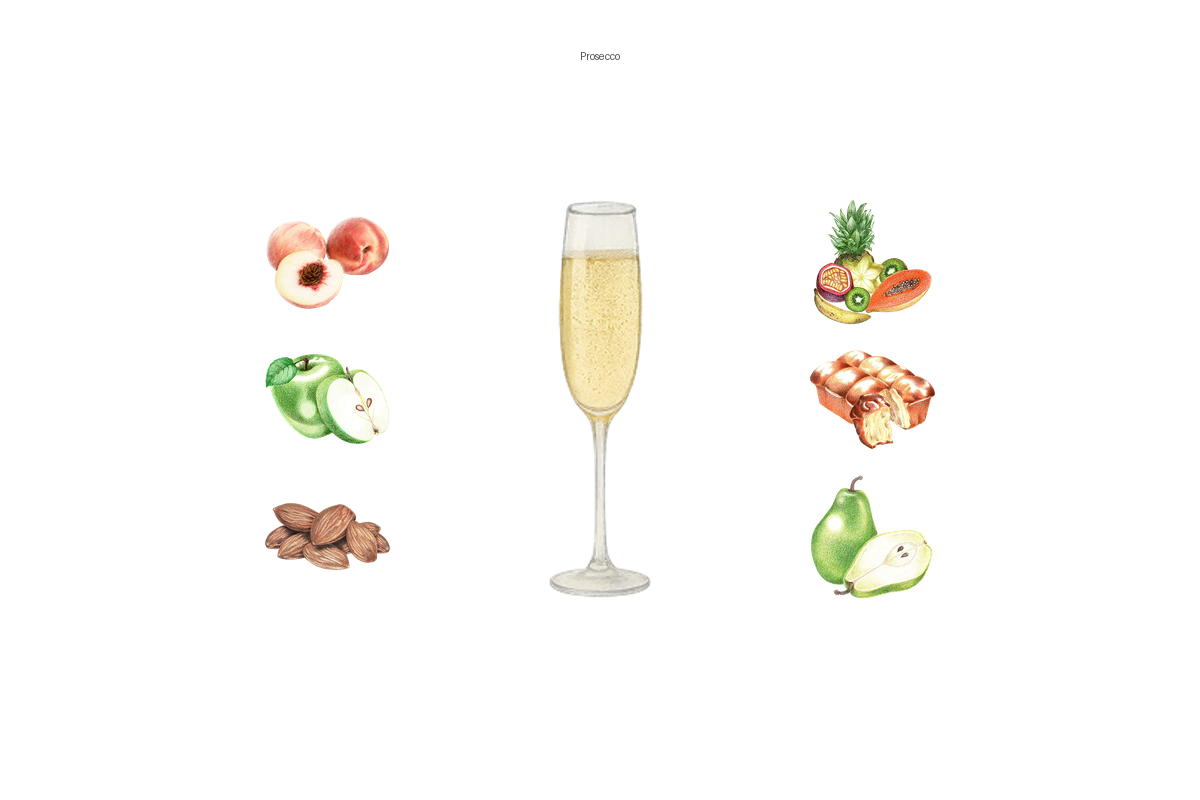Characteristics of Prosecco
Prosecco’s signature style comes from the Glera grape, which brings lively acidity and delicate floral aromas, complemented by flavors of green apple, pear, and white peach. Most Prosecco is Spumante, the most sparkling style, but you’ll also find Frizzante (lightly sparkling) and Tranquillo (still); the alcohol content typically ranges from 11-12% ABV.
For Prosecco Rosé, 10-15% Pinot Noir is blended with Glera, and only the Spumante style is permitted, giving a hint of red fruit and a blush of color. Sweetness levels range from bone-dry Brut Nature to sweeter Demi-Sec, and there’s even a traditional bottle-fermented style called ‘Col Fondo’ or ‘Sui Lieviti’ for those seeking something unique.
What Does Prosecco Taste Like?
The flavor profile of Prosecco is shaped significantly by its region of origin and production method:
-
DOC vs. DOCG Areas: Wines from the broader DOC region tend to showcase classic notes of crisp green apple, pear, white peach, and citrus, with lively floral aromatics. In contrast, Prosecco from more specific DOCG zones—such as Rive or Cartizze—often express greater complexity, sometimes revealing subtle hints of almond, herbs, or even a delicate minerality.
-
Col Fondo Style: This traditional, unfiltered style introduces bready or yeasty undertones, adding textural depth and savory nuance alongside the typical fruit and floral character.
-
Sweetness Levels: The perceived sweetness (from Brut to Extra Dry) can amplify ripe fruit flavors, with even drier styles sometimes tasting slightly sweet due to the wine’s exuberant fruitiness.
Notable Region Prosecco Grows In
The character and quality of Prosecco are shaped by its distinct hillside terroirs and the strict regulations of its appellation system, resulting in a diverse range of expressions across the region.
-
Prosecco DOC: Covering nine provinces in Veneto and Friuli, this broad area delivers fresh, approachable wines in Spumante, Frizzante, Tranquillo, and Rosé styles, making Prosecco widely accessible.
-
Conegliano Valdobbiadene Prosecco Superiore DOCG: Sourced from steep, UNESCO-listed hills, these wines are celebrated for their complexity, lower yields, and a clear sense of place.
-
Superiore di Cartizze: Known as Prosecco's "Grand Cru," this prized subzone within Conegliano Valdobbiadene produces exceptional, traditionally Dry style wines from a unique, south-facing vineyard.
-
Rive: Representing 43 single-village sites within the DOCG, Rive wines are hand-harvested and vintage-specific, highlighting the unique character of each steep vineyard.
-
Asolo Prosecco Superiore DOCG: From the hills around Asolo, this smaller DOCG produces structured, mineral-driven wines, is known for pioneering drier styles like Extra Brut, and features the distinctive "Sui Lieviti" (on the lees) style.
Food Pairings
Prosecco’s vibrant bubbles and refreshing acidity make it a versatile partner at the table, elevating both casual snacks and elegant meals.
-
Appetizers & Seafood: Prosecco’s lively character pairs effortlessly with antipasti like prosciutto, olives, and bruschetta, while its crispness complements oysters, shrimp, and delicate white fish, enhancing both the flavors and textures.
-
Cheeses, Poultry & Brunch: Whether served with creamy Brie, fresh mozzarella, or aged Parmigiano-Reggiano, Prosecco’s gentle effervescence balances rich and soft cheeses; it also shines alongside chicken, turkey, fried chicken, and classic brunch fare such as smoked salmon and egg dishes.
-
Global Cuisine & Sweet Finishes: Extra Dry and Dry styles beautifully offset the spice and freshness of sushi, Thai, and Vietnamese dishes, while sweeter Proseccos are a natural match for fruit-forward desserts, light cakes, and even dark chocolate—just be sure to match the sweetness of the wine to the dish for the most harmonious pairing.
















